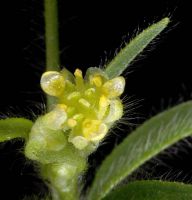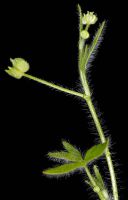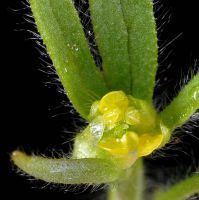Distribution: Occurring east of the Cascades crest in Washington; Washington to Baja California, east to Idaho and Arizona.
Habitat: Moist to rather dry hillsides and woodlands.
Flowers: March-May
Origin: Native
Growth Duration: Annual
Conservation Status: Threatened in Washington (WANHP)
Pollination: Bees, flies, butterflies, beetles
Delicate annual with soft, fine hairs and filiform roots, the stems moderately branched, erect, 1-2.5 dm. tall.
Basal leaves with long, slender petioles, the blades 5-10 mm. long, cordate, 3-parted and lobed; cauline leaves alternate, the blades to 20 mm. long and 30 mm. wide, ternate and lacerate-lobed into oblong segments.
Flowers on slender pedicles 1-2 cm. long; sepals 5, petaloid, soft-hairy, 1-1.5 mm. long; petals pale yellow, 1-5 or lacking, equalling the sepals but narrower; nectary above the midpoint of the petal, the scale glabrous, attached only by the broad base, deltoid; receptacle globose, glabrous; stamens 6-15.
Achenes 4-10, nearly circular, compressed, about 2 mm. long, covered with numerous short, hooked bristles; stylar beak stout, slightly hooked.
Publication: Bot. Beechey Voy. 316. 1838.
PNW Herbaria: Specimen records of Ranunculus hebecarpus in the Consortium of Pacific Northwest Herbaria database
WA Flora Checklist: Ranunculus hebecarpus checklist entry
OregonFlora: Ranunculus hebecarpus information
E-Flora BC: Ranunculus hebecarpus atlas page
CalPhotos: Ranunculus hebecarpus photos















